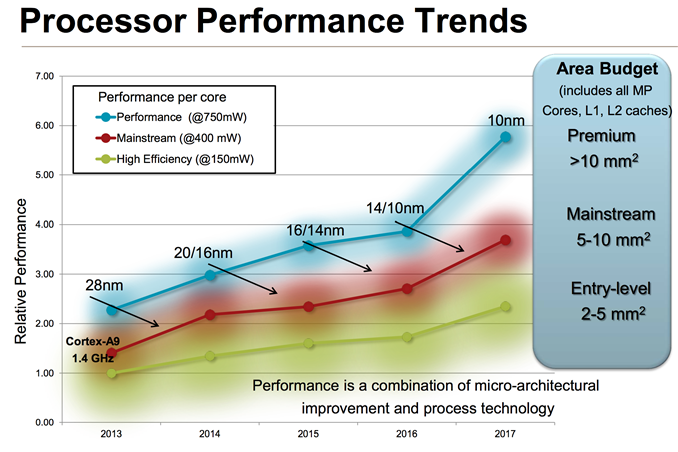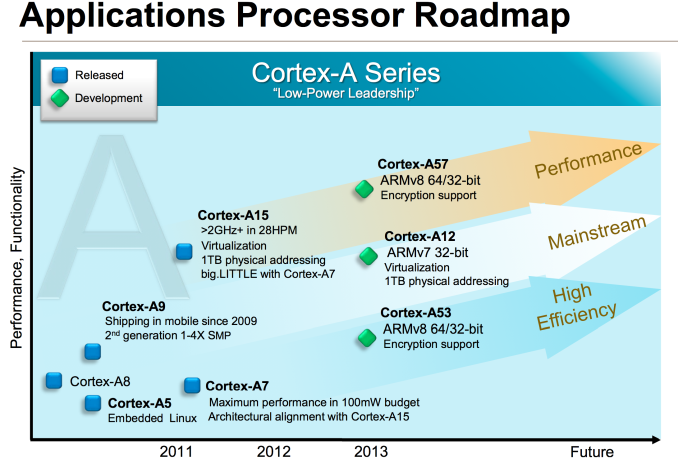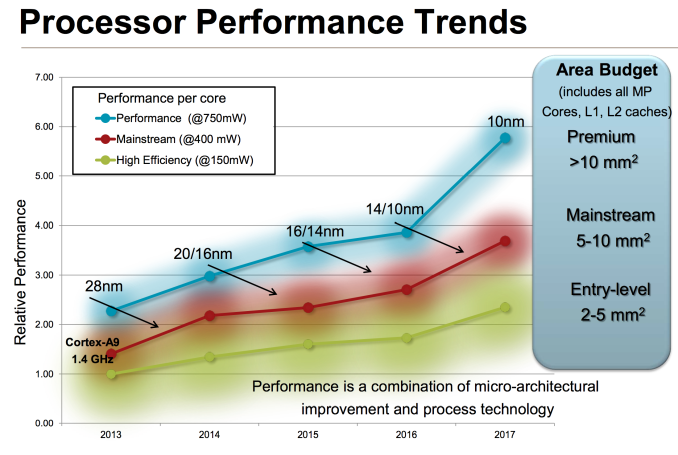The ARM Diaries, Part 2: Understanding the Cortex A12
by Anand Lal Shimpi on July 17, 2013 12:30 PM EST- Posted in
- CPUs
- Arm
- SoCs
- Cortex A12

A couple of weeks ago I began this series on ARM with a discussion of the company’s unique business model. In covering semiconductor companies we’ve come across many that are fabless, but it’s very rare that you come across a successful semiconductor company that doesn’t even sell a chip. ARM’s business entirely revolves around licensing IP for its instruction set as well as its own CPU (and now GPU and video) cores.
Before we get into discussions of specific cores, it’s important to talk about ARM’s portfolio as a whole. In the PC space we’re used to focusing on Intel’s latest and greatest microarchitectures, which are then scaled in various ways to hit lower price targets. We might see different core counts, cache sizes, frequencies and maybe even some unfortunate instruction set tweaking but for the most part Intel will deliver a single microarchitecture to cover the vast majority of the market. These days, this microarchitecture is simply known as Core.
Back in 2008, Intel introduced a second microarchitecture under the Atom brand to target lower cost (and lower power) markets. The combination of Atom and Core spans the overwhelming majority of the client computing market for Intel. The prices of these CPUs range from the low double digits with Atom to many hundreds of dollars for the highest end Core processors (the most expensive desktop Haswell is $350, however mobile now extends up to $1100). There are other designs that target servers (which are then repurposed for ultra high-end desktops), but those are beyond the scope of this discussion for now.
If we limit our discussion to personal computing devices (smartphones, tablets, laptops and desktops), where Intel uses two microarchitectures ARM uses three. The graphic below illustrates the roadmap:
You need to somewhat ignore the timescale on the x-axis since those dates really refer to when ARM IP is first available to licensees, not when products are shipping to consumers, but you get an idea for the three basic vectors of ARM’s Cortex A-series of processor IP. Note that there are also Cortex R (embedded) and Cortex M (microcontroller) series of processor IP offered as well, but once again those are beyond the scope of our discussion here.
If we look at currently available cores, there’s the Cortex A15 on the high end, Cortex A9 for the mainstream and Cortex A7 for entry/low cost markets. If we’re to draw parallels with Intel’s product lineup, the Cortex A15 is best aligned with ultra low power/low frequency Core parts (think Y-series SKUs), while the Cortex A9 vector parallels Atom. Cortex A7 on the other hand targets a core size/cost/power level that Intel doesn’t presently address. It’s this third category labeled high efficiency above that Intel doesn’t have a solution for. This answers the question of why ARM needs three microarchitectures while Intel only needs two: in mobile, ARM targets a broader spectrum of markets than Intel.
Dynamic Range
If you’ve read any of our smartphone/tablet SoC coverage over the past couple of years you’ll note that I’m always talking about an increasing dynamic range of power consumption in high-end smartphones and tablets. Each generation performance goes up, and with it typically comes a higher peak power consumption. Efficiency improvements (either through architecture, process technology or both) can make average power in a reasonable workload look better, but at full tilt we’ve been steadily marching towards higher peak power consumption regardless of SoC vendor. ARM provided a decent overview of the CPU power/area budget as well as expected performance over time of its CPU architectures:
Looking at the performance segment alone, we’ll quickly end up with microarchitectures that are no longer suited for mobile, either because they’re too big/costly or they draw too much power (or both).
The performance vector of ARM CPU IP exists because ARM has its sights set higher than conventional smartphones. Starting with the Cortex A57, ARM hopes to have a real chance in servers (and potentially even higher performance PCs, Windows RT and Chrome OS being obvious targets).
Although we see limited use of ARM’s Cortex A15 in smartphones today (some international versions of the Galaxy S 4), it’s very clear that for most phones a different point on the power/performance curve makes the most sense.
The Cortex A8 and A9 were really the ARM microarchitectures that drove smartphone performance over the past couple of years. The problem is that while ARM’s attentions shifted higher up the computing chain with Cortex A15, there was no successor to take the A9’s place. ARM’s counterpoint would be that Cortex A15 can be made suitable for lower power operation, however its partners (at least to date) seemed to be focused on extracting peak performance from the A15 rather than pursuing a conservative implementation designed for lower power operation. In many ways this makes sense. If you’re an SoC vendor that’s paying a premium for a large die CPU, you’re going to want to get the most performance possible out of the design. Only Apple seems to have embraced the idea of using die area to deliver lower power consumption.
The result of all of this is that the Cortex A9 needed a successor. For a while we’d been hearing about a new ARM architecture that would be faster than Cortex A9, but lower power (and lower performance) than Cortex A15. Presently, the only architecture in between comes from Qualcomm in the form of some Krait derivative. For ARM to not let its IP licensees down, it too needed a solution for the future of the mainstream smartphone market. Last month we were introduced to that very product: ARM’s Cortex A12.
Slotting in numerically between A9 and A15, the initial disclosure unfortunately didn’t come with a whole lot of actual information. Thankfully, we now have some color to add.












65 Comments
View All Comments
Krysto - Saturday, July 20, 2013 - link
The difference is those ARM chips do take full advantage of the maximum core speed. Saying you start a web page - any web page. It WILL activate the maximum clock speed - whereas the Turbo-Boost in Atom doesn't activate all the time.If we're talking about receiving notifications and such, then obviously the ARM processors won't go to 2 Ghz either, but that's not really what we're talking about here, is it? We're talking about what happens when you're doing normal heavy stuff (web browsing, apps, games).
jeffkibuule - Monday, July 22, 2013 - link
That's the problem I have with performance benchmarks on cell phones. At some point thermal throttling kicks in because you're draining the battery a ton running your CPUs at full tilt. IPC improvements will be felt far more than clock speed ramping. If you ever look at CPU-Z on Android, you'll notice that a Snapdragon 600 with 4 cores clocked at 1.7Ghz tries its hardest to downclock to 1 core at 384Mhz. Even just scrolling up and down the monitoring screen pumps up the CPU speed to 1134Mhz and turns on a second core as well. Peak performance is nice, but ideally should rarely be utilized.Krysto - Saturday, July 20, 2013 - link
No, I meant it's a problem because Atom chips look like they are "competitive" in benchmarks, when in reality they have HALF the performance. That's what I was saying. It's a problem for US, not Intel. Intel wins by being misleading.felixyang - Thursday, July 18, 2013 - link
intel didn't mislead you. In SLM's review, they have very clear description about turbo. Copied here.Previous Atom based mobile SoCs had a very crude version of Intel’s Turbo Boost. The CPU would expose all of its available P-states to the OS and as it became thermally limited, Intel would clamp the max P-state it would expose to the OS. Everything was OS-driven and previous designs weren’t able to capitalize on unused thermal budget elsewhere in the SoC to drive up frequency in active parts of chip. ........ this is also how a lot of the present day ARM architectures work as well. At best, they vary what operating states they expose to the OS and clamp max frequency depending on thermals.
opwernby - Thursday, July 18, 2013 - link
That's not cheating: it's what compilers are supposed to do. For example, if you write, "for (i=0; i<1000; i++);" a good optimizing compiler will analyze the loop, realize that it does nothing, resolve it to "i=1000;" and compile that. I believe the first use of this type of aggressive compiler technology was seen in Sun's C compiler for whatever version of Solaris it was that ran on the Sparc chips back in the '80s. The fact that the ARM compilers didn't do this speaks more about the expected performance of the chipset than anything else: you can build hardware to be as fast as you like, but if the compilers can't keep up, you might as well be running your code on a Commodore Pet.opwernby - Thursday, July 18, 2013 - link
Speaking of the Sun thing: I distinctly remember that the then-current version of the Sun "pizza-box"-style workstation appeared in benchmarks to be 100 times faster than the IBM PC-RT (another RISC architecture competing with Sun's platform) even though, on paper, the PC-RT was running on faster hardware: analysis of the benchmarks' compiled code revealed that Sun's compiler had effectively edited out the loops as I described above. Result: the PC-RT died off very quickly.FunBunny2 - Friday, July 19, 2013 - link
The PC-RT didn't last long, but the processor (in its children) lives on as the RS-6000/PPC/iSeries/ZWilco1 - Thursday, July 18, 2013 - link
It's certainly cheating, if you followed the whole thing it was not just about ICC optimizing much of the benchmark away. The particular optimization was added recently to ICC - it was a lot more complex than an empty loop, it only optimized a very specific loop by a huge factor (so specific that if you compiled all open source code it would likely only apply to the benchmark and nothing else). For some odd reason AnTuTu then secretly switched to that ICC version despite ICC not being a standard Android compiler. Finally it turned out the settings for ARM were non-optimal, using an older GCC version with pretty much all loop optimizations disabled. Intel and ABI research then started making false claims on how fast Atom was compared to Galaxy S4 based on the parts of AnTuTu that were broken (without actually mentioning AnTuTu).Giving one side such a huge unfair advantage is called cheating. As a result AnTuTu will now stop using ICC.
jwcalla - Thursday, July 18, 2013 - link
This is why benchmarks have to be taken with a healthy dose of skepticism.First, if the benchmark program isn't open source, right off the bat it's worthless. If you can't see the code, you can't trust it.
Second, if the program isn't compiled with the same compiler and the same compiler options, the results are crap. You're not getting a valid comparison of the hardware itself.
It's kind of ridiculous seeing many of the journalists out there who took this sensational headline and ran with it without even questioning its legitimacy.
Wilco1 - Wednesday, July 17, 2013 - link
The IPC comparison for integer code goes like:Silverthorne < A7 < A9 < A9R4 < Silvermont < A12 < Bobcat < A15 < Jaguar
This is based on fair comparisons using Geekbench and so doesn't reflect what some marketing departments claim or what cheated benchmarks (ie. AnTuTu) appear to show.